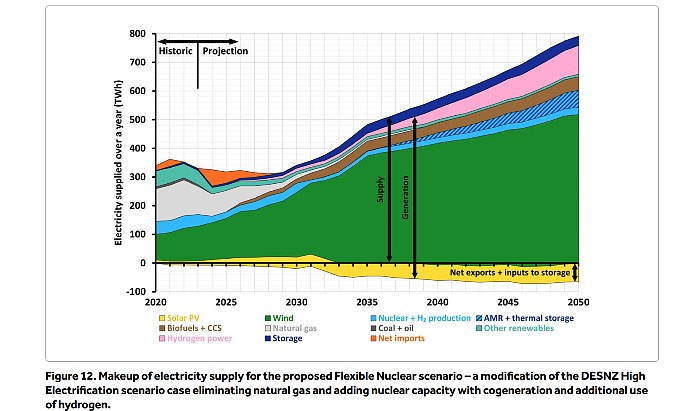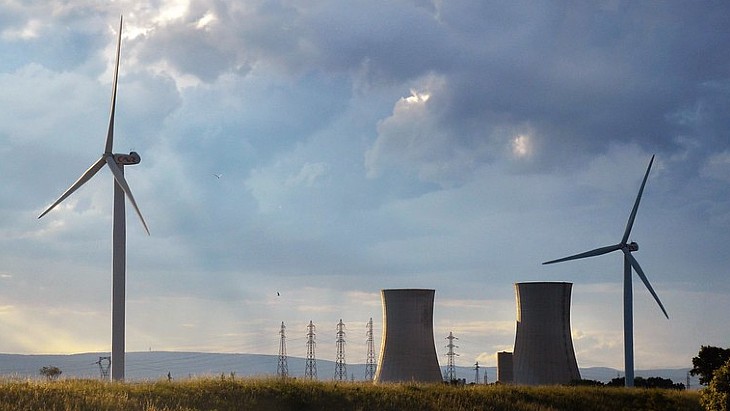The report, The road to net zero: renewables and nuclear working together, says that such a change could help the UK to achieve its goal of a net-zero power and energy system by 2050, while creating more jobs and lowering the projected costs by up to GBP14 billion (USD17.9 billion).
Zara Hodgson, Director of the Dalton Nuclear Institute, University of Manchester, says in its foreword: "The UK has been highly successful in driving forward the expansion of renewable energy to displace fossil fuel burning power plants ... yet, wind and solar are inherently variable ... the installation of backup natural gas burning power plants and energy storage technologies has so far been the proposed solution to the UK’s changeable island weather, despite drawbacks of high-cost electricity, wasted energy and continued CO2 emissions.
"So we have asked ourselves if the UK should look again at how nuclear electricity and nuclear heat could accelerate the renewable energy technology led transition to net-zero, and also underpin UK leadership in addressing climate change."
The potential fossil-free energy future scenario "to spark further discussion" is for electrification of more than 840 TWh total supply; three-quarters of which is supplied by variable renewable energy, 10% by nuclear plants and 0% from fossil fuels. That would be roughly doubling the current overall supply and also the current UK nuclear output.

In the report's “Flexible Nuclear” scenario, nuclear energy primarily delivers heat to produce hydrogen and other fuels that are essential to decarbonise the UK, with renewables delivering the bulk of the electricity generation, and when renewable output drops nuclear energy is then diverted to generate electricity for the grid, thus avoiding the need to have new gas-fired power plants designed only to be used to cover times of low renewables output.
The co-authors Juan Matthews, William Bodel and Gregg Butler say that in current official UK modelling, nuclear is seen as a baseload energy source, with gas generation to operate for "only a small percentage of the time" and note that "seemingly cheap sources of electricity become expensive when their capacity factor is reduced" as well as the potential cost of having to curtail energy production at times of maximum generation from renewable sources.
"One method of improving flexibility of nuclear power is to combine it with thermal storage. The higher temperatures produced by some AMRs (advanced modular reactors) make them particularly suited to production of hydrogen and other synthetic fuels, as well as heating for a large range of industrial applications. This potential is further exploited in several AMR conceptual designs that choose to incorporate molten salt thermal storage ... this arrangement of a reactor plus thermal store opens the prospect of broader commercial uptake by end users, through considerable availability of economic, flexible, useful energy output, and should be investigated," the report says.
It explains that the thermal storage concept follows experience with solar thermal power, "where it has been proved effective and economic in countries with abundant sunshine ... molten salts are used to store heat in large, insulated silos, and the molten salts are then run though steam generators or heat exchangers. The cooled molten salt is then stored in separate silos to be used in the next cycle ... alternatively, the heat can be stored in large, insulated masses of cheap solid materials such as sand or gravel which are heated and depleted by molten salts, but this system has a lower thermal efficiency than the two-tank molten salt option ... several AMR conceptual designs include molten salt thermal storage combined with energy conversion plants up to three times the capacity of the reactor system. At times of low electricity demand, energy is directed to the heat store; at times of high demand, this stored heat energy can be converted into electricity along with the reactor’s output. This allows continuous operation of a reactor plant while allowing unrestricted load following, including at very low levels of electricity delivery to the grid".
It recommends that the UK government should prioritise research to enable in-depth investigation of the opportunities to use reactors with thermal storage. It also recommends that government assessments of the impact of new nuclear capacity should recognise and incorporate cogeneration applications and says "government and industry should aim to reduce the need for curtailment of renewable electricity by using cogenerated nuclear heat to power high-temperature electrolysis hydrogen production, in addition to short-term storage", while "planning for future nuclear deployment should envisage an integrated system where nuclear and variable renewables work in harmony through cogeneration and energy storage, while planning around energy (not just electricity) infrastructure delivery should be fully coordinated to best ensure the UK has a functional whole system".
For potential next steps it says "further research and development into thermal energy storage technology is necessary, as the technology’s engineering feasibility is central to achieving the potential economic benefits of the Flexible Nuclear approach".
Zara Hodgson adds: "Our analysis indicates future promise for a flexible, fossil fuel free energy system that integrates the synergistic advantages of renewable energy and cogenerating nuclear energy, as the technologies become deployable in the system from now to 2030, then onto 2040, and finally full implementation by 2050. Capitalising on the flexibility of nuclear energy to contribute more than just low-carbon electricity is a key innovation opportunity for the UK and offers leadership in international net-zero initiatives and enhanced energy security."






_63865.jpg)
_18570.jpg)
_16159.jpg)





